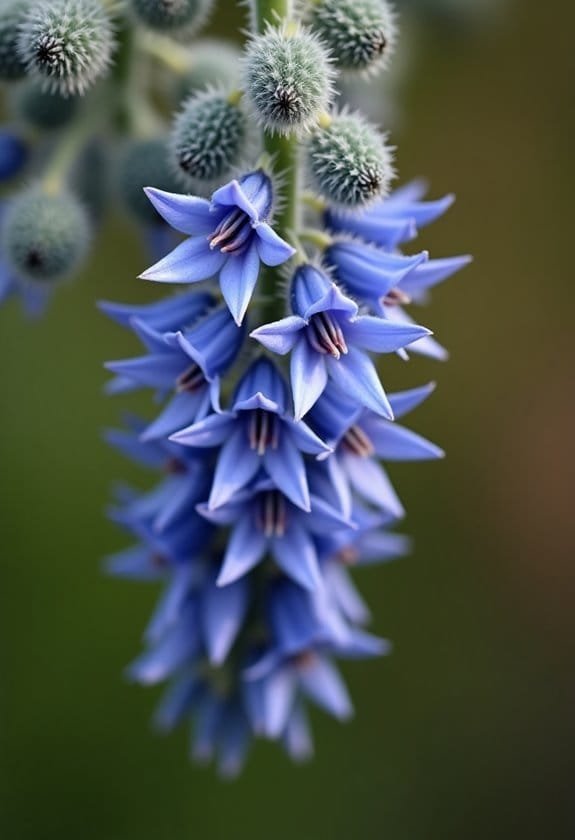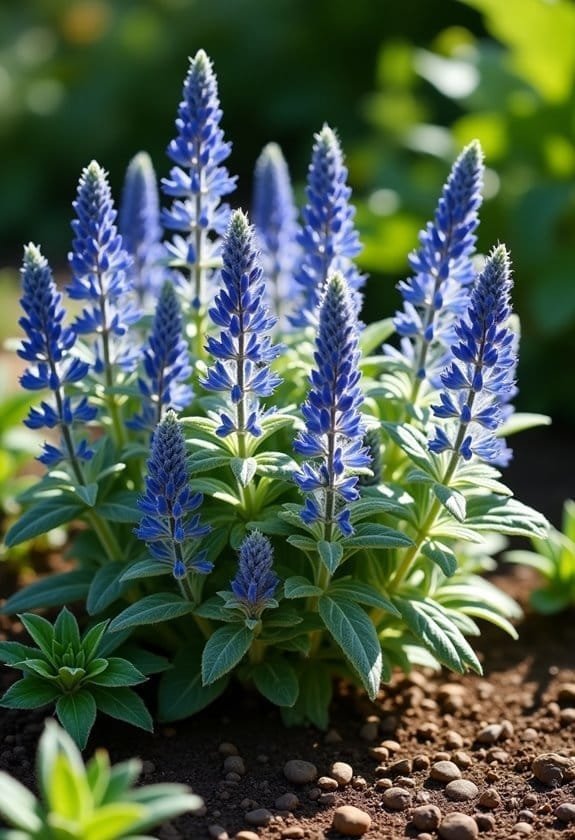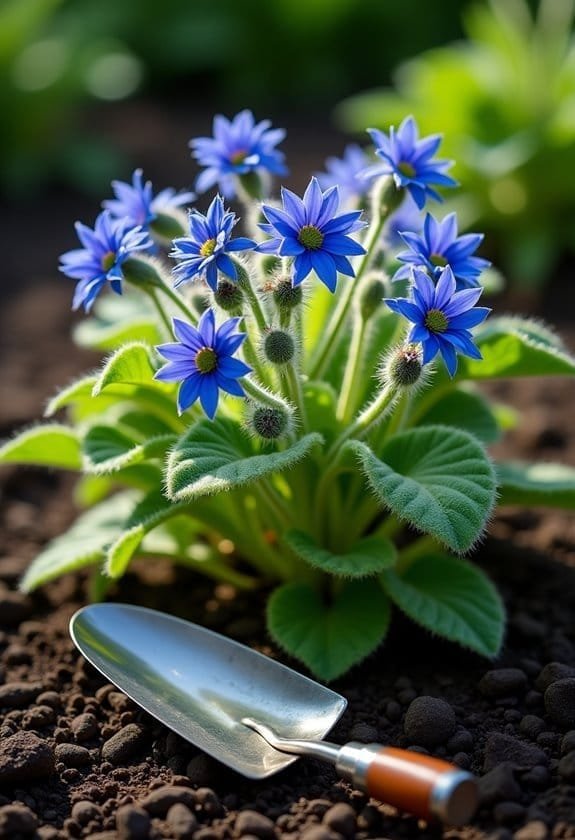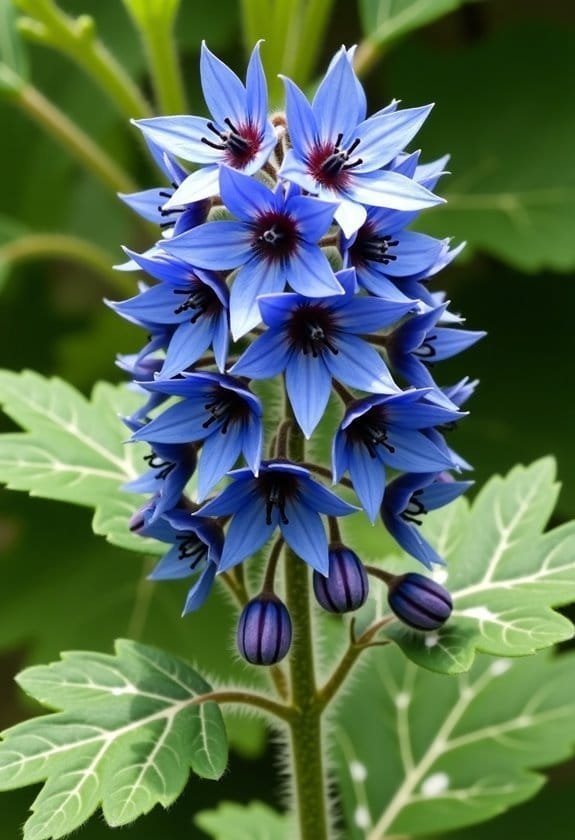Borago officinalis, commonly known as borage, is a versatile annual herb reaching heights of 60-100 cm, distinguished by its striking blue star-shaped flowers and fuzzy gray-green leaves. It thrives in well-drained soil with full sun exposure, requiring at least four hours of direct sunlight daily for ideal growth. The plant's edible flowers and leaves offer a rejuvenating cucumber-like flavor, making them popular additions to salads, beverages, and garnishes. Beyond its culinary applications, borage serves as a powerful pollinator magnet, attracting beneficial insects while containing valuable compounds that suggest promising therapeutic potential.
Main Points
- Borago officinalis is an annual herb with striking blue star-shaped flowers and coarse, hairy leaves growing 60-100 cm tall.
- The plant's edible flowers and leaves have a cucumber-like flavor, commonly used in salads, beverages, and Mediterranean cuisine.
- Borage thrives in well-drained soil with full sun exposure, requiring at least 4 hours of direct sunlight daily.
- The flowers attract beneficial pollinators, especially bees, making it excellent for companion planting with strawberries and tomatoes.
- While offering nutritional benefits, borage contains pyrrolizidine alkaloids, requiring careful consumption and professional guidance for medicinal use.
Introduction

Borage (Borago officinalis), a robust Mediterranean herb known for its striking blue star-shaped flowers, has cultivated a notable presence in both ornamental gardens and culinary traditions.
The annual herb stands proudly at 60 to 100 centimeters tall, featuring distinctive gray-green leaves covered in coarse hairs and producing clusters of vibrant blossoms that attract beneficial pollinators.
While its cucumber-flavored leaves and flowers have earned it recognition in kitchens worldwide, this versatile plant's historical significance extends beyond its culinary applications to include traditional medicinal uses.
However, modern science urges careful consumption due to its pyrrolizidine alkaloid content.
Common Name
The bright star-shaped flowers of this versatile herb have earned it the common name "starflower," though it's also widely known as borage. This enchanting plant, scientifically classified as Borago officinalis L., carries multiple common names that reflect its diverse characteristics and historical applications throughout different cultures and regions.
Among its various colloquial designations, "tailwort" stands as another frequently used name, highlighting the plant's traditional role in both culinary preparations and medicinal treatments. The name "starflower" particularly resonates with gardeners and naturalists, as it perfectly captures the visual appeal of the plant's striking blue blooms, which form a distinctive five-pointed star pattern when fully opened.
These common names have become deeply ingrained in horticultural circles, where borage is celebrated not only for its ornamental value but also for its remarkable ability to attract beneficial pollinators.
The plant's cucumber-like flavor has further cemented its position in kitchen gardens, while its scientific classification within the Boraginaceae family provides a formal foundation for botanical studies and research applications.
Scientific Name
Nomenclature authorities recognize Borago officinalis L. as the scientific name for this star-flowered herb, placing it firmly within the Boraginaceae family of flowering plants. This formal taxonomic designation carries significant weight in botanical circles, providing a universal reference point for researchers and horticulturists worldwide.
The scientific name's construction reveals important details about the plant's discovery and classification history. The genus name "Borago" stems from Latin origins, reflecting the plant's distinctive bristly characteristics and traditional applications in medicine and cuisine.
When followed by "officinalis," which denotes historical medicinal use, the name creates a clear taxonomic identity that distinguishes it from related species. The suffix "L." holds particular significance in botanical nomenclature, as it credits the renowned Swedish botanist Carl Linnaeus with the plant's first formal description.
While native to Mediterranean regions, Borago officinalis has demonstrated remarkable adaptability, establishing itself across diverse geographical zones. This scientific naming convention provides a foundation for understanding the plant's evolutionary relationships and facilitates accurate communication among botanists, gardeners, and herbalists worldwide.
Overview
Beyond its formal scientific designation, this striking Mediterranean herb has captured gardeners' attention worldwide with its distinctive star-shaped blue flowers and versatile applications. Borage (Borago officinalis) stands as a remarkable annual herb that commands attention in any garden setting, reaching impressive heights of 60-100 centimeters while displaying its characteristic gray-green, wrinkled foliage adorned with bristly hairs.
This adaptable plant has established itself as a valuable addition to both ornamental and culinary gardens, offering a fascinating combination of aesthetic appeal and practical benefits. Its ability to self-seed guarantees a persistent presence in gardens, while its cucumber-like flavor profile makes it a prized ingredient in various culinary applications.
The plant's dual role as both a companion plant and pollinator attractor strengthens garden ecosystems, though careful consideration must be given to its consumption due to the presence of pyrrolizidine alkaloids. In well-drained soils and full sun exposure, borage flourishes across European and North American gardens, demonstrating its remarkable adaptability to diverse growing conditions while maintaining its Mediterranean charm.
Key Features
Borage stands as a striking garden presence, reaching heights of 60-100 cm with its bristly stems and rough-textured leaves that span 5-15 cm in length.
The plant's most distinctive feature lies in its star-shaped flowers, which showcase five narrow triangular-pointed petals mainly in vibrant blue, though pink and white variations occasionally emerge.
These eye-catching blooms appear throughout the growing season, typically from late spring through early autumn, making borage a reliable source of continuous garden interest and pollinator attraction.
Growth Size
The robust nature of this medicinal herb reveals itself through its impressive growth dimensions, reaching heights of 60-100 cm (2-3+1⁄2 ft) with a spread of 30-45 cm (1-1.5 ft).
As an annual plant, borage exhibits remarkable growth characteristics, developing its distinctive bristly stems and broad leaves within a relatively short period of eight weeks post-planting.
The plant's structural framework supports alternating simple leaves that span 5-15 cm (2-6 in) in length, creating a substantial green canopy that contributes to its commanding presence in herb gardens.
During its peak growing season from June through September, borage transforms into a flowering powerhouse, with clusters of vivid blue blossoms dominating the upper portions of the plant.
While the species demonstrates adaptability to various soil conditions, its most vigorous growth occurs in well-drained locations with full sun exposure.
This hardy herb's ability to self-seed guarantees its continued presence in gardens, as new generations emerge naturally each growing season, maintaining the plant's established footprint within its designated growing space.
Appearance
Standing out in herb gardens, this distinctive plant catches the eye with its rough, weedy appearance and striking blue star-shaped flowers. The dominant genetic trait for blue blooms occasionally gives way to pink or white variants, creating a fascinating display during its peak flowering season from June through September.
The plant's most distinguishing characteristics lie in its robust foliage structure, featuring greenish-gray leaves that measure between 5 and 15 centimeters in length. These leaves possess a remarkable fuzzy texture due to their covering of bristly hairs, which contribute to the plant's distinctive tactile quality and rustic charm.
When prepared for culinary purposes, the leaves reveal an unexpected similarity to cucumbers, offering a subtle salty flavor that surprises many first-time gardeners.
Throughout its growth cycle, borage maintains a commanding presence, stretching between 60 and 100 centimeters tall. Its architectural form combines a somewhat untamed, naturalistic appearance with the refined beauty of its star-shaped blooms, making it an eye-catching addition to any garden setting where its unique characteristics can be fully appreciated.
Flowering Season
During peak summer months, borage bursts into bloom with a spectacular display that extends from June through September in temperate regions. This resilient flowering plant produces an abundance of star-shaped blooms, primarily in striking blue hues, though pink and white varieties also emerge throughout the season.
The extended flowering period of borage makes it particularly valuable for both ornamental gardens and agricultural purposes, as its continuous bloom supports pollinator populations through late summer. Its flowers demonstrate remarkable reproductive efficiency through geitonogamy, a self-pollination mechanism that guarantees robust seed production even when external pollinators are scarce.
The plant's prolific nectar production attracts numerous beneficial insects, especially bees, throughout its flowering cycle.
Each flower exhibits five distinctive triangular petals, with the genetically dominant blue coloration creating stunning visual displays in gardens. These edible flowers maintain their sweet, honey-like flavor throughout the blooming season, making them consistently reliable for culinary applications from early summer through autumn's approach, when the flowering gradually diminishes.
Growing Requirements

Borage's growing requirements center on its Mediterranean origins, demanding full sun exposure with a minimum of four hours of direct sunlight daily for robust growth and abundant flowering.
The plant adapts well to various soil conditions but flourishes in well-draining, slightly acidic soil where seeds should be sown 1/4 to 1/2 inch deep, with mature plants spaced 18-24 inches apart.
While drought-tolerant once established, borage needs consistent moisture during its early development phase, and regular maintenance through deadheading and midsummer pruning promotes extended blooming periods.
Light
Most successful borage plants thrive in full sun conditions, requiring a minimum of 4 hours of direct sunlight daily for ideal growth and flowering. While these hardy plants demonstrate remarkable adaptability to various garden environments, optimal light exposure remains essential for achieving robust growth and abundant blooms.
Although borage can tolerate light shade, insufficient sunlight often leads to noticeable changes in the plant's development and flowering patterns. Regular monitoring of light conditions helps gardeners identify potential issues before they substantially impact the plant's health, as stunted growth and reduced blooming can indicate inadequate sun exposure.
The plant's natural resilience allows it to withstand varying temperature conditions, though it's vital to recognize its vulnerability to hard frost.
Borage's self-seeding characteristic makes it particularly adept at establishing itself in locations with favorable light conditions year after year. This natural propagation tendency guarantees that subsequent generations benefit from previously tested growing environments, making it an efficient addition to gardens where consistent light patterns prevail throughout the growing season.
Soil
While many plants demand specific soil conditions, borage demonstrates remarkable adaptability across various soil types, though it performs best in well-drained, slightly acidic to neutral environments.
This hardy annual's resilience allows it to thrive even in less-than-ideal soil compositions, making it an excellent choice for both novice and experienced gardeners.
For peak growth, wait until the soil has warmed in spring before sowing seeds at a depth of 1/4 to 1/2 inch, ensuring proper germination and strong root development.
While borage can tolerate poor soil conditions, incorporating organic matter into the growing medium will enhance its importance and overall performance.
When cultivating borage in containers, select vessels at least 12 inches deep with sufficient drainage holes to prevent waterlogging and subsequent root rot.
The plant's moisture requirements follow a distinct pattern: consistent watering during its establishment phase shifts to impressive drought tolerance once mature.
This adaptability to varying soil conditions, combined with its minimal maintenance needs, makes borage an exceptionally forgiving plant that rewards gardeners with robust growth and abundant blooms.
Water
Proper watering practices play an essential role in borage cultivation, particularly during its establishment phase when the soil must remain consistently moist. During this significant period, regular watering guarantees strong root development and sets the foundation for healthy plant growth, though careful attention must be paid to avoid waterlogged conditions.
Once established, borage demonstrates remarkable adaptability to varying moisture conditions, developing a natural resistance to drought that makes it a versatile addition to diverse garden settings.
Container-grown specimens, however, require more frequent attention to their water needs, as the confined soil volume tends to dry out more rapidly than ground-planted counterparts. Gardeners should monitor soil moisture levels regularly, adjusting watering frequency based on environmental conditions and container specifications.
To maintain ideal plant health, it's vital to strike a balance between adequate hydration and avoiding excessive moisture. Overwatering can lead to destructive conditions like root rot and powdery mildew, while insufficient water stresses the plant and inhibits growth.
A practical approach involves checking soil moisture regularly and allowing the top layer to dry slightly between waterings.
Temperature
Successful borage cultivation depends on maintaining temperatures between 60°F and 75°F (15°C to 24°C), which provides the perfect environment for growth and flowering.
While the plant demonstrates remarkable adaptability to various growing conditions, it exhibits vulnerability to hard frost, making temperature management essential for ideal development.
When establishing new plants, gardeners should wait until soil temperatures have sufficiently warmed and nighttime temperatures consistently remain above freezing before transplanting seedlings outdoors.
Though borage can withstand warmer conditions, elevated temperatures necessitate increased attention to watering practices to prevent the plant from experiencing heat stress.
The relationship between temperature and plant health becomes particularly evident during flowering periods, as fluctuating temperatures can greatly impact bloom production and overall plant well-being.
For maximum success in borage cultivation, maintaining steady temperature conditions proves important throughout the growing season.
Gardeners in regions with extreme temperature variations may need to implement protective measures, such as mulching or temporary covers, to moderate soil temperature and shield plants from unexpected temperature fluctuations that could compromise their development.
Pollinator Criteria
Borage's striking star-shaped blue flowers serve as powerful magnets for a diverse array of pollinators, particularly honeybees seeking both nectar and pollen.
The plant's extended blooming period from June through September creates a reliable food source during vital months when pollinators are most active.
Through its self-seeding capabilities and pollinator-friendly flower structure, borage establishes itself as a cornerstone species in ecological gardens, supporting not only pollinating insects but also beneficial predators that maintain natural pest control.
Attracted Pollinators
The star-shaped blue flowers of borage serve as powerful magnets for pollinators, particularly honeybees seeking nectar and pollen. These vibrant blooms produce copious amounts of both resources, making them irresistible to various beneficial insects throughout the summer months.
From June through September, borage's extended flowering period provides a reliable food source for diverse pollinator populations, including native bees, butterflies, and even the occasional hummingbird. The plant's abundant nectar production and easily accessible pollen make it an excellent choice for supporting local pollinator communities, while its self-seeding nature guarantees continuous garden presence year after year.
The contribution of borage to garden biodiversity extends beyond its role as a nectar source, as it creates a sustainable ecosystem for multiple pollinator species. Its star-shaped flowers, positioned on gracefully arching stems, offer convenient landing platforms for both large and small pollinators.
This architectural feature, combined with the plant's prolific blooming habit, transforms gardens into thriving pollinator havens, supporting local food webs and enhancing overall ecosystem health.
Pollination Method
While pollinators flock to borage's inviting blooms, this resilient herb maintains a unique reproductive strategy through self-pollination. The plant's distinctive star-shaped flowers contain both male and female reproductive organs, allowing for efficient self-fertilization without requiring external assistance.
Despite its self-sufficient nature, borage has evolved to maximize reproductive success by attracting a diverse array of pollinators, particularly honeybees, during its extended summer flowering period from June through September.
The flowers' accessible structure features prominently displayed reproductive parts and abundant nectar production, creating an ideal environment for both self-pollination and cross-pollination opportunities.
This dual approach to reproduction demonstrates borage's remarkable adaptability, as it can successfully propagate in environments where pollinator populations might be limited.
The plant's ability to thrive in challenging conditions, combined with its self-pollinating capability, guarantees consistent seed production throughout the growing season.
Meanwhile, the attraction of pollinators serves to enhance genetic diversity when cross-pollination occurs, contributing to the species' overall resilience and adaptability across various ecological conditions.
Care & Maintenance

Successful borage cultivation starts with selecting a sunny location that receives at least 4 hours of direct sunlight and preparing well-draining soil enriched with organic matter.
Once established, these hardy plants need consistent moisture during their early growth phase, followed by reduced watering schedules that allow the soil to dry between hydration cycles.
Borage's robust nature makes it an excellent companion for strawberries and tomatoes, while its pest-resistant qualities and dense growth habit help protect neighboring plants from common garden threats.
Planting Tips
Growing borage requires attention to a few key planting considerations. When starting borage (Borago officinalis) from seeds indoors, proper spacing and depth are essential for successful germination and establishment. Plant seeds approximately 1/4 to 1/2 inch deep in well-draining containers, ensuring adequate moisture until seedlings emerge.
For ideal growth, select a planting location that receives at least 4 hours of direct sunlight daily, as this Mediterranean herb thrives in full sun exposure. The soil should be slightly acidic and well-draining, though borage's adaptable nature allows it to flourish in various soil conditions.
Once seedlings reach 6-8 inches in height, transplant them to their permanent location, spacing plants 18-24 inches apart to accommodate their mature size and spreading habit.
During the establishment phase, maintain consistent soil moisture without waterlogging, as excessive water can lead to root problems. After plants are established, reduce watering frequency, allowing the soil to dry between waterings, as borage's drought-tolerant nature becomes evident.
This resilient herb will reward proper planting with vigorous growth and abundant blue blooms throughout the growing season.
Ongoing Care
Once established, borage plants need consistent but minimal maintenance to thrive throughout the growing season. The key to success lies in providing adequate sunlight, with plants requiring a minimum of four hours of direct sun daily to achieve ideal flowering and robustness.
Proper watering practices are essential for borage's development, maintaining evenly moist soil during the establishment phase while allowing mature plants to experience slight drying between waterings.
Container-grown specimens typically demand more frequent hydration due to increased moisture evaporation. Regular fertilization with a phosphorus-rich, edible plant formula supports vigorous blooming and sustained growth throughout the season.
Pruning plays an important role in maintaining borage's health and productivity. Deadheading spent blooms encourages continuous flowering, while a midsummer reduction by half rejuvenates the plant for late-season harvests.
While borage demonstrates natural resistance to most pests and diseases, vigilant monitoring for signs of water-related stress helps prevent common issues like powdery mildew, ensuring the plant's continued health and ornamental appeal throughout its growing cycle.
Suggested Companions
Companion planting with borage creates a symphony of mutual benefits in the garden ecosystem. This versatile companion plant demonstrates remarkable synergy with tomatoes, offering natural protection against tomato hornworms while enhancing the fruits' flavor profile through proximity planting.
In vegetable gardens, borage's presence proves particularly valuable alongside squash and cucumber varieties, where its prolific flowers attract beneficial insects essential for successful pollination.
The plant's cooperative relationship extends to legumes, where borage aids in nitrogen fixation when planted near beans, creating a naturally enriched soil environment that benefits both species.
Strawberry patches particularly thrive with borage as a companion, as the herb's protective properties help ward off common strawberry pests while contributing to increased fruit production.
When integrated into herb gardens, borage forms powerful alliances with aromatic plants like basil and mint, establishing a diverse habitat that supports a wide spectrum of beneficial insects.
This intentional combination of plants not only promotes a healthier garden ecosystem but also creates an efficient, self-sustaining environment where each species contributes to the overall success of the garden community.
Common Issues
While borage is generally robust, it faces several notable challenges including powdery mildew in humid conditions and potential root rot from oversaturated soil.
Proper air circulation and careful moisture management are essential defenses against these issues, as the plant's susceptibility increases dramatically in damp, crowded growing conditions.
Though generally pest-resistant, borage can attract unwanted insects when stressed, making regular monitoring and immediate intervention vital for maintaining the plant's health and preventing the spread of diseases.
Pests/Diseases
Despite being a hardy and resilient plant, borage can face a handful of common garden issues. Powdery mildew stands as the most notable pest or disease concern, particularly when environmental conditions create excess moisture or stagnant air around the plant's dense foliage.
While this fungal infection may appear alarming, it rarely causes severe damage to the plant's overall health or affects the amounts of pyrrolizidine alkaloids present in its tissues.
Aphids occasionally make an appearance on borage plants, clustering primarily on the undersides of leaves and along tender stems. However, these small insects typically don't require intervention, as borage's natural resilience and beneficial insect populations usually keep their numbers in check.
The plant's robust nature means that most pest and disease issues resolve themselves with minimal human intervention, though maintaining proper air circulation and avoiding overwatering considerably reduces potential problems.
Gardeners should monitor their plants regularly for signs of stress, particularly during periods of high humidity or unusual weather patterns, as early detection allows for simple cultural adjustments rather than requiring more intensive treatments.
Solutions
Several straightforward solutions exist for common borage growing issues. The most critical approach involves optimizing growing conditions through proper soil drainage and ensuring adequate sunlight exposure, as borage plants require at least four hours of direct sun daily to maintain robust growth patterns.
To combat potential powdery mildew infections, gardeners should implement strategic spacing between plants and maintain proper air circulation, while simultaneously monitoring moisture levels to prevent excessive dampness around the foliage.
Regular deadheading of spent blooms not only enhances the plant's aesthetic appeal but also promotes continuous flowering throughout the growing season.
For those concerned about leaf toxicity, implementing a measured approach to harvesting and consuming leaves and flowers is essential.
Practicing staggered planting techniques creates an extended harvest window, allowing gardeners to maintain smaller, consistent yields rather than overwhelming quantities at once. This method particularly benefits those who wish to maintain a steady supply while adhering to moderate consumption guidelines, especially for sensitive individuals such as expectant mothers.
Summary

Throughout history, borage has served as a versatile herb prized for both its ornamental and practical qualities. The remarkable borage (Borago officinalis), an annual plant native to Mediterranean regions, stands as a demonstration to nature's multifaceted gifts, reaching heights of one to three feet with its distinctive gray-green foliage and vibrant blue flowers.
This remarkable plant offers a thorough package of benefits that extends far beyond its aesthetic appeal. Its edible flowers and leaves provide a rejuvenating cucumber-like flavor to culinary creations, while its nutritional profile boasts significant levels of vitamin C and essential minerals.
The seeds yield valuable oil containing 26-38% gamma-linolenic acid, which has demonstrated promising anti-inflammatory properties. In garden settings, borage serves as a powerful pollinator magnet, attracting beneficial insects that enhance local biodiversity.
However, it's important to emphasize the presence of pyrrolizidine alkaloids, which necessitate careful consumption guidelines, particularly for sensitive populations. This balance of benefits and considerations exemplifies borage's complex nature as both a beneficial herb and one requiring informed usage.


